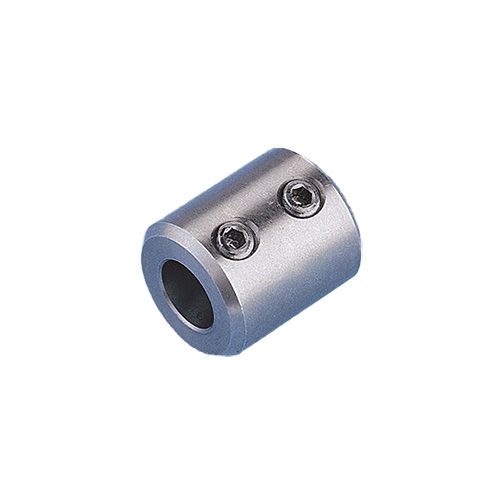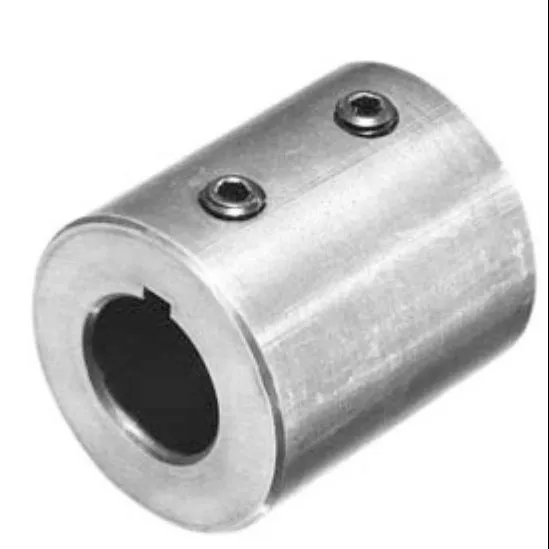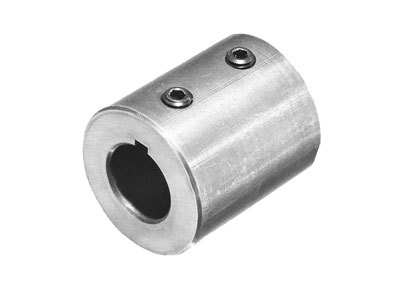Product Description
XLT Star Type Flexible Coupling (JB/T10466-2004)
♦Description
♦Basic Parameter and Main Dimension(JB/T3241-1991)
Note:
N.m= Norminal torque; d1.d2= Diameter of shaft hole
1. The value of A can be determined according to the needs of users, but the mass of the intermediate sleeve should not be greater than 1.6% of the circumference force at 0.78D calculated according to the norminal torque.
2. The critical speed should be checked.
Other products
♦Other Products List
| Transmission Machinery Parts Name |
Model |
| Universal Coupling | WS,WSD,WSP |
| Cardan Shaft | SWC,SWP,SWZ |
| Tooth Coupling | CL,CLZ,GCLD,GIICL, GICL,NGCL,GGCL,GCLK |
| Disc Coupling | JMI,JMIJ,JMII,JMIIJ |
| High Flexible Coupling | LM |
| Chain Coupling | GL |
| Jaw Coupling | LT |
| Grid Coupling | JS |
Company Profile
♦Our Company
HangZhou CHINAMFG Machinery Manufacturing Co., Ltd. is a high-tech enterprise specializing in the design and manufacture of various types of coupling. There are 86 employees in our company, including 2 senior engineers and no fewer than 20 mechanical design and manufacture, heat treatment, welding, and other professionals.
Advanced and reasonable process, complete detection means. Our company actively introduces foreign advanced technology and equipment, on the basis of the condition, we make full use of the advantage and do more research and innovation. Strict to high quality and operate strictly in accordance with the ISO9000 quality certification system standard mode.
Our company supplies different kinds of products. High quality and reasonable price. We stick to the principle of “quality first, service first, continuous improvement and innovation to meet the customers” for the management and “zero defect, zero complaints” as the quality objective.
♦Our Services
1.Design Services
Our design team has experience in cardan shaft relating to product design and development. If you have any needs for your new product or wish to make further improvements, we are here to offer our support.
2.Product Services
Raw materials → Cutting → Forging →Rough machining →Shot blasting →Heat treatment →Testing →Fashioning →Cleaning→ Assembly→ Packing → Shipping
3.Samples Procedure
We could develop the sample according to your requirement and amend the sample constantly to meet your need.
4.Research & Development
We usually research the new needs of the market and develop the new model when there is new cars in the market.
5.Quality Control
Every step should be special test by Professional Staff according to the standard of ISO9001 and TS16949.
♦FAQ
Q 1: Are you trading company or manufacturer?
A: We are a professional manufacturer specializing in manufacturing various series of couplings.
Q 2: Can you do OEM?
Yes, we can. We can do OEM & ODM for all the customers with customized artworks of PDF or AI format.
Q 3: How long is your delivery time?
Generally it is 20-30 days if the goods are not in stock. It is according to quantity.
Q 4: Do you provide samples? Is it free or extra ?
Yes, we could offer the sample but not for free. Actually we have a very good price principle, when you make the bulk order then cost of sample will be deducted.
Q 5: How long is your warranty?
A: Our Warranty is 12 months under normal circumstance.
Q 6: What is the MOQ?
A: Usually our MOQ is 1 pcs.
Q 7: Do you have inspection procedures for coupling ?
A: 100% self-inspection before packing.
Q 8: Can I have a visit to your factory before the order?
A: Sure,welcome to visit our factory.
Q 9: What’s your payment?
A: T/T.
♦Contact Us
Web: huadingcoupling
Add: No.11 HangZhou Road,Chengnan park,HangZhou City,ZheJiang Province,China
/* January 22, 2571 19:08:37 */!function(){function s(e,r){var a,o={};try{e&&e.split(“,”).forEach(function(e,t){e&&(a=e.match(/(.*?):(.*)$/))&&1

Can Sleeve Couplings Accommodate Axial and Angular Misalignments Simultaneously?
Yes, sleeve couplings are designed to accommodate both axial and angular misalignments simultaneously. They offer a certain degree of flexibility, allowing them to compensate for minor misalignments between the shafts they connect. Here’s how sleeve couplings handle axial and angular misalignments:
1. Axial Misalignment:
Axial misalignment refers to the misalignment that occurs along the axis of the connected shafts. In other words, one shaft is slightly offset from the other along their common centerline. Sleeve couplings can tolerate a small amount of axial misalignment because of their flexible nature.
When axial misalignment occurs, the sleeve coupling can flex along its length, allowing the shafts to remain connected despite the slight offset. The coupling’s flexibility prevents excessive stress on the connected machinery and helps maintain a smooth torque transmission.
2. Angular Misalignment:
Angular misalignment, on the other hand, occurs when the two shafts are not perfectly aligned in the same plane. Instead, they form an angle with each other. Sleeve couplings can also accommodate a certain amount of angular misalignment.
When angular misalignment is present, the sleeve coupling can bend and twist slightly to compensate for the angle between the shafts. This ability to flex and twist ensures that the coupling can transmit torque efficiently and reduces the risk of premature wear or damage to the system.
Simultaneous Axial and Angular Misalignment:
Sleeve couplings are well-suited to handle both axial and angular misalignments simultaneously. When a system experiences both types of misalignments, the sleeve coupling’s flexibility allows it to adjust and compensate for both the axial offset and angular deviation between the shafts.
It is important to note that while sleeve couplings can handle some misalignments, excessive misalignments should be avoided to prevent excessive wear and premature failure of the coupling. Regular inspections and maintenance can help ensure that the coupling operates within its designed misalignment limits and maintains optimal performance in the motion control system.
In summary, sleeve couplings can simultaneously accommodate both axial and angular misalignments to a certain extent due to their flexible and forgiving design. However, it is essential to ensure that the system is well-aligned and that the coupling is regularly inspected to ensure it functions correctly and provides reliable power transmission in various industrial applications.

How do Sleeve Couplings Compare to Other Coupling Types, such as Flexible or Rigid Couplings?
Sleeve couplings, flexible couplings, and rigid couplings are three common types of couplings used in mechanical power transmission. Each type has its unique characteristics and applications. Here’s a comparison of sleeve couplings with flexible and rigid couplings:
- Sleeve Couplings: Sleeve couplings are simple and cost-effective couplings that join two shafts end-to-end. They provide some flexibility to accommodate slight shaft misalignments and are suitable for low to moderate torque applications. They are easy to install and do not require extensive maintenance. However, they have limited misalignment compensation and cannot handle significant shaft offsets.
- Flexible Couplings: Flexible couplings are designed to handle greater misalignments compared to sleeve couplings. They can accommodate angular, parallel, and axial misalignments, providing higher flexibility. Flexible couplings dampen vibrations and reduce shock transmission, contributing to smoother operation. They are available in various designs such as elastomeric, beam, and disc couplings, each offering specific benefits. Flexible couplings are ideal for applications where misalignments, vibrations, or shock loads are significant.
- Rigid Couplings: Rigid couplings are designed to connect shafts in a straight and rigid manner, without any flexibility. They provide accurate shaft alignment, making them suitable for precision applications. Rigid couplings are robust and transmit torque with high efficiency. However, they cannot accommodate misalignments and are susceptible to vibrations and shocks. Rigid couplings are commonly used in applications where precise shaft alignment is critical.
Choosing the appropriate coupling type depends on the specific requirements of the application:
- Alignment Requirements: If the application demands accurate shaft alignment and no misalignment compensation is needed, rigid couplings are suitable. For moderate misalignments, sleeve couplings may be sufficient, while flexible couplings are preferred for significant misalignments.
- Vibration and Shock Damping: If vibration and shock absorption are essential, flexible couplings are preferred due to their ability to dampen vibrations. Sleeve couplings have limited vibration damping capabilities, while rigid couplings do not dampen vibrations.
- Torque and Load: For low to moderate torque and loads, sleeve couplings are cost-effective choices. For higher torque applications with misalignment compensation, flexible couplings are preferred. Rigid couplings are suitable for high torque and precise alignment applications.
In summary, sleeve couplings provide a basic connection between shafts with limited misalignment compensation. Flexible couplings offer higher misalignment accommodation and vibration damping, making them versatile for various applications. Rigid couplings excel in precise shaft alignment requirements but lack flexibility and shock absorption.

What is a Sleeve Coupling, and How is it Used in Mechanical Power Transmission?
A sleeve coupling is a type of flexible coupling used in mechanical power transmission to connect two shafts and transmit torque between them. It consists of a hollow cylindrical sleeve with an inner diameter that matches the shafts’ outer diameters. The sleeve coupling is placed over the ends of the shafts, and its flexibility allows for some misalignment between the shafts while transmitting rotational power from one shaft to the other.
The sleeve coupling is a simple and cost-effective coupling solution commonly used in various industrial applications. Its design allows for easy installation and maintenance, making it suitable for applications where frequent shaft disconnection and reconnection are required.
Here’s how a sleeve coupling works in mechanical power transmission:
- Shaft Connection:
The sleeve coupling connects two shafts that need to be linked together to transmit power.
- Flexible Design:
The flexibility of the sleeve coupling allows for some angular and axial misalignment between the shafts. This flexibility is achieved due to the clearance between the inner diameter of the sleeve and the outer diameter of the shafts.
- Torque Transmission:
When one shaft rotates, it transfers torque to the sleeve coupling. The flexible nature of the coupling allows it to compensate for minor misalignments and still transmit torque smoothly to the other shaft.
- Reduced Vibration and Shock Absorption:
The flexibility of the sleeve coupling also helps dampen vibrations and absorb shocks, preventing them from transferring between the connected shafts. This feature contributes to the smooth and efficient operation of the connected machinery.
- Limitations:
Sleeve couplings have their limitations, including lower torsional stiffness compared to other coupling types, which may limit their use in precision applications with high torque and speed requirements. Additionally, sleeve couplings are not suitable for applications with significant misalignments or when precise angular alignment is crucial.
In summary, a sleeve coupling is a flexible and straightforward coupling used in mechanical power transmission to connect two shafts while allowing for some misalignment. Its simple design and ability to absorb shocks and dampen vibrations make it a popular choice for various industrial applications where precision alignment is not critical.


editor by CX 2024-03-13
